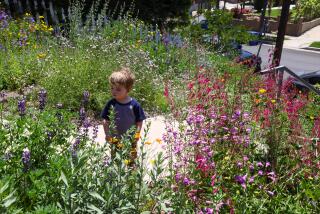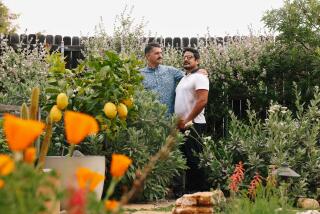The Shady but Colorful Characters Out There
- Share via
Cool, green and lush . . . or boring, bland and colorless--both are descriptions of shade gardens, depending on the gardener’s point of view and skill.
A shade garden can be merely an afterthought, with token impatiens tucked against a north wall or scattered around the base of a tree. Designed with care, however, a shade garden can be a fragrant, colorful respite from the burning sun.
“Shade gardens can be very beautiful and very useful, such as tranquil seating areas or screening off unwanted views,” said Colleen Bushinsky, who along with Kaye Miller owns and operates the Posie Pushers. The Garden Grove firm designs, installs and maintains custom flower gardens.
There are different kinds and degrees of shade: partial shade, light shade, medium shade, full shade and dense shade.
“In our climate, most plants actually do better if they get some protection from the fierce summer afternoon sun,” she added. “Partial or light shade does this.”
But she cautions against the tendency to plunk in shade-loving plants such as impatiens or primroses and consider that a complete garden.
“These colorful flowers are more like cherries on the top of a hot fudge sundae,” Bushinsky said. “First you have to build the layers of the garden, just as you would a sundae. The trimmings come last.”
When Bushinsky designs a shade garden, she specifies shrubs for definition, feeling and flow.
“Select some nice, big shrubs that also provide colorful flowers or berries,” she recommends. “These are like the ice cream that starts a sundae. Then drop down in height to medium-size plants that are knee-high, about 2 1/2 feet when mature. These plants are like adding the syrup or hot fudge.”
Among her favorites for large shrubs are Justicia carnea (Brazilian plume flower), Abutilon hybridium (flowering maple or Chinese bellflower) and Acer palmatum (Japanese maple).
“Justicia is such a beautiful plant; I can’t understand why more people aren’t using it,” she said. “An evergreen shrub with dense clusters of hot pink flower plumes in summer and fall, it’s easy to trim to shape and adds a lot of color.”
For gardens with a tropical feel, she likes to use Australian or New Zealand tree ferns and Schefflera actinophylla (Queensland umbrella tree), which can soar to 20 feet. For mid-size plants, she recommends hydrangeas, especially lace-cap varieties, fuchsias, which thrive along the coast, and azaleas.
For fragrance, she suggests Sarcococca ruscifolia, a slow-growing evergreen shrub with waxy, deep green leaves and tiny white, very fragrant flowers that bloom in early spring with a delicate apricot scent.
Another fragrant and showy shrub is Brunfelsia pauciflora ‘Floribunda’, popularly nicknamed ‘Yesterday, Today and Tomorrow’ because the blossoms quickly change color from purple to lavender to white.
Another variety of brunfelsia that Bushinsky recommends is B.p. ‘Macrantha,’ which grows lower than B.p. ‘Floribunda’ and has larger leaves and large flowers, up to 2 inches in diameter. Each flower is deep purple with a lavender zone that borders a white throat.
For potent fragrance, she likes to include Cestrum nocturnum (night jessamine). The clusters of creamy white flowers that appear in summer are so strongly redolent that some people prefer to banish this plant to the perimeter of the property, where its nightly perfume can billow through the house and patio without overpowering anyone.
For clients who enjoy hot colors, such as orange, she includes Clivia miniata accented with various types of ferns.
For some gardeners, shade is synonymous with ferns. Mona Lisa Borad, manager of Village Nursery in Huntington Beach, recommends Asplenium bulbiferum (mother fern), which thrives in dense or medium shade; Microlepia strigosa (lace fern), robust with delicate fronds; and Rumohra adiantiformis (leatherleaf fern), with deeply glossy fronds that are useful in cut-flower arrangements.
When it’s time to add the cherries, the sprinkles of color for the shade garden, Bushinsky adds impatiens, bergenia, cineraria, campanula, primroses or begonias, depending on the season.
“I like to mass impatiens by color for added drama,” she said. “To provide year-round interest, I recommend tearing out impatiens by the end of summer when they start to get straggly and replacing them with primroses. Then by May, when the primroses are finished, it’s time to replant the area with impatiens. Never cut impatiens to encourage new blooms after Thanksgiving. The rainy season rots them out.”
For a statement, she prefers pots of New Guinea impatiens, valued for variegated foliage and large flowers. She clusters several in one container and adds lobelia for an accent.
“I prefer them in pots on decks or patios,” she said. “They grow too large in the garden.”
Bushinsky rigorously avoids hosta, though its admirers are many.
“Putting hostas in gardens in our region is just like ringing the dinner bell and standing back to watch the stampede of snails and slugs,” she said with a laugh. “It’s just not worth the battle.”
Other shade-thriving plants that she avoids include astilbe and dicentra (bleeding heart). “I love to use plants that last for a long time with minimal effort, and these just don’t fit that category in our region.”
*
Shade loving plants require rich, acid soil. Because Orange County soil is alkaline, gardeners need to amend the soil with peat moss.
“It’s a safe bet that anything that grows in the shade needs lots of peat moss,” Bushinsky said. “When preparing a new garden bed, you should spread coarse peat moss on the top, cultivate and water heavily.
“If you’re adding one or two plants, dig the hole 1/2-inch larger than the plant’s root ball and backfill the hole with half soil and half wet peat moss.”






